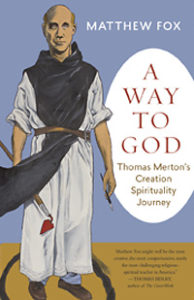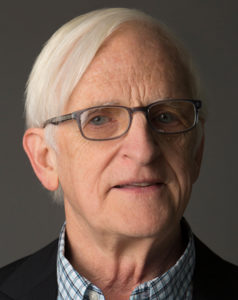Excerpt from Matthew Fox’s “A Way to God: Thomas Merton’s Creation Spirituality”
 In 2015, preeminent theologian and bestselling author Matthew Fox was invited by the Thomas Merton Center in Louisville, KY, to give a lecture to honor the centennial year of the legendary Catholic monk and writer’s birth. In preparing for the talk, Fox re-immersed himself in Merton’s work and revisited the correspondence he had with him while he was alive. As Fox read through Merton’s journals, poetry, and religious writings, he realized that his exploration was inspiring far more than just one talk.
In 2015, preeminent theologian and bestselling author Matthew Fox was invited by the Thomas Merton Center in Louisville, KY, to give a lecture to honor the centennial year of the legendary Catholic monk and writer’s birth. In preparing for the talk, Fox re-immersed himself in Merton’s work and revisited the correspondence he had with him while he was alive. As Fox read through Merton’s journals, poetry, and religious writings, he realized that his exploration was inspiring far more than just one talk.
The result is A Way to God:Thomas Merton’s Creation Spirituality, a powerful book about Merton’s pioneering work in deep ecumenism and interfaith; about his essential teachings on mixing contemplation and action; and about how the vision of thirteenth century mystic Meister Eckhart profoundly influenced both Merton and Creation Spirituality, which Fox has long espoused and written about.
We hope you’ll enjoy this short excerpt from the book, which explores the Four Paths of Creation Spirituality:
What are the Four Paths of Creation Spirituality and how real were they to Thomas Merton? In September 1968, he shared a circular letter that succinctly summarized the spiritual journey that the Four Paths represent: Our real journey in life is interior; it is a matter of growth, deepening, and of an ever greater surrender to the creative action of love and grace in our hearts. Never was it more necessary for us to respond to that action.
How do we grow, deepen, and surrender to love and grace and action? That is where the Four Paths come in and assist us in naming our deepest journey.
- Via Positiva: This is the path of wonder and awe. Or as Merton begins: “Our real journey in life is interior; it is a matter of growth, deepening.” Awe is an inner response, an opening to the beauty and wonder of life and God.
- Via Negativa: This is the path of letting go and letting be, of solitude and silence, but also of undergoing grief and sorrow; it’s an ongoing act of radical trust in the Divine. Eckhart calls it “sinking eternally into the One,” and Merton refers to it when he mentions “an ever greater surrender.”
- Via Creativa: This is the path of celebration and creativity, of cocreating with the work of the Holy Spirit. Or as Merton says, it’s “the creative action of love and grace in our hearts.”
- Via Transformativa: This is the path of compassion and justice; it is the way of the prophet who calls us to action. The Holy Spirit moves us not just to contemplate Divine compassion, but to enact it in the world in order to help others. Merton voices this when he says, “Never was it more necessary for us to respond to that action.”
There can be no question that Merton lives and writes a Creation Spirituality, and he dances through the Four Paths back and forth on a regular basis. His Creation Spirituality journey began about a decade before his death. In February 1958, he summarized the new path he felt he needed to take: The frustration of the American intellectual who can’t get along without a Europe that can no longer sustain him. (Yet — he is sustained, without knowing it, by his own latent vitality.) This has been to a great extent my own frustration as a writer — from which I escaped temporarily “upward” — into spirituality — but that was not enough, because it is not a matter of escape, but of incarnation and transformation.
In this moment, Merton was on the cusp of moving away from the Augustinian and Neoplatonic “upwardness” of his early years. That same year, 1958, Pope Pius XII died and Pope John XXIII was elected, and within a few years, Pope John would call for a Second Vatican Council to redirect the church. With the help of Meister Eckhart and D.T. Suzuki, Merton learned to redefine spirituality in a way that was more ecumenical and more prophetic, more grounded and earthy. He no longer “escaped upward” away from matter, but he reimmersed himself in incarnation and transformation. He moved from a “Climbing Jacob’s ladder” mentality so basic to patriarchy to a “Dancing Sara’s Circle” mentality that was far more democratic and grounded and bodily and feminist. As a monk, Merton moved from contemplation alone to the vocation of the mystic as prophet, or the contemplative in action. Clearly, it was a Creation Spirituality journey.
 Matthew Fox is the author of over 30 books including Meister Eckhart, The Hidden Spirituality of Men, Christian Mystics, and most recently A Way to God. A preeminent scholar and popularizer of Western mysticism, he became an Episcopal priest after being expelled from the Dominican Order by Cardinal Ratzinger, who later became Pope Benedict XVI. You can visit him online at www.matthewfox.org.
Matthew Fox is the author of over 30 books including Meister Eckhart, The Hidden Spirituality of Men, Christian Mystics, and most recently A Way to God. A preeminent scholar and popularizer of Western mysticism, he became an Episcopal priest after being expelled from the Dominican Order by Cardinal Ratzinger, who later became Pope Benedict XVI. You can visit him online at www.matthewfox.org.
Excerpted from A Way to God: Thomas Merton’s Creative Spirituality Journey. Copyright © 2016 by Matthew Fox.
